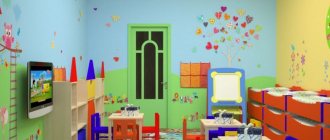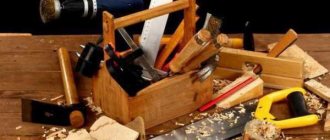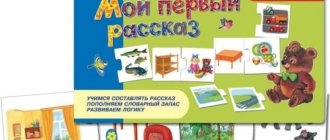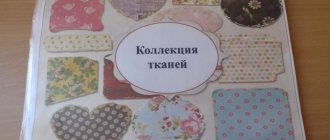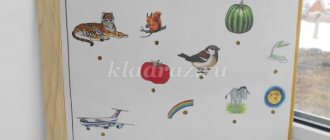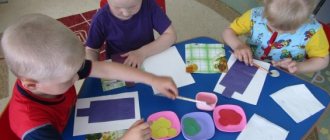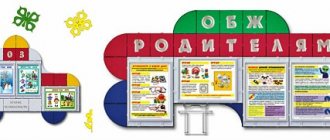Good afternoon, dear readers! Today we have an interesting and important topic on the creative development of children. Decorating fine art corners is also an art. There is no doubt that the majority of preschoolers love to draw. This is how they discover and explore the world, learn new things. You can familiarize yourself with the corresponding useful publication by the author N.G. Panteleeva. Kids enjoy drawing and being creative in art classes. Some of the children like to look at albums with paintings by artists or folk crafts. The development of aesthetic taste and creativity is undoubtedly the most important point in education.
Design of fine art corners according to modern standards (FSES)
Respected educators can become wonderful assistants in the knowledge of beauty. An arts and crafts area must be included in the group for the development of creative activity in children. And the bright and colorful design of the fine arts corner will attract children to creativity faster. I would immediately like to recommend a series by I. Lykova on creative activities in the garden. I would like to recommend the next publication , as well as this manual . For the older group, good examples of work are also given to help.
It must be remembered that according to the standard, when creating a corner, a group passport will be required. It is stored directly in the documents of the teacher or in the activity area in the group. The passport includes a description of the group, its number, the age of the children, the purpose of its creation, and the assigned tasks. A list of furniture, tools and materials must also be indicated. It is necessary to mention the number and function of posters, diagrams and other visual materials.
Modern standards of the Federal State Educational Standard dictate certain conditions so that the design of the corners of the fine art is competent. It must meet hygiene requirements. The place where the corner items are located should be well lit. It is advisable to place it near a window. Also, chairs and tables should correspond to the growth characteristics of each age group. The choice of equipment and tools should meet the needs of children.
The fact is that each age group has a certain uniqueness. And the design of the corners of the fine art should be age-appropriate. For example, children in the nursery group are going through a process of adaptation. In this regard, teachers do not need to regularly change the design of the corner. There is no need for kids to be distracted by new objects. A familiar environment without frequent innovations contributes to a softer and faster adaptation for the child.
As for the middle and older groups, the color scheme and information about art are expanding more actively. The displays in the corner can be changed more often, presenting more complex objects. It is proposed to use scissors in work under the supervision of a teacher. It is also possible to use materials such as coal and sanguine in creativity. I recommend reading this software and methodological complex .
Aesthetics, beauty and creative change
We introduce beauty from an early age. The Fine Art corner should be not only practical, but also beautiful. It needs to be designed so that preschoolers can admire its appearance. That is, they learn to appreciate beauty and acquire the ability to enjoy it. The inclusion of children in the design of toys and children's works also plays a big role. This is how we begin to develop “childish” design in children.
Of course, if the objects in the corner do not change for a long time, the children will begin to lose interest. From time to time, as you study a new topic, you need to change and add materials. Also, conditions for children’s creativity must be created in the corner. Children should have the opportunity to sit next to a corner, color a picture or look at an album with creative works.
Decorating a corner in the junior group of a kindergarten with your own hands: Russian folk art
Decorating a corner in the junior group of the kindergarten “Russian Folk Art”
Author: Beloglazova Elena Aleksandrovna, teacher of the kindergarten “Alyonushka”, Novokuibyshevsk, Samara region. Description: this publication will be of interest to kindergarten teachers. Goal: Decorating a corner in the junior group of the kindergarten “Russian folk art” Objectives: - to introduce younger preschoolers to the origins of Russian folk art; — to involve parents of pupils in the design of the corner - “Russian folk art” My work as a kindergarten teacher began in the junior group, we got the group after kindergarten graduates, so the important point was the design of the group, the creation of a subject-spatial environment that would be comfortable and met the age requirements of children. Dear colleagues, I propose to your attention the design of the “Russian Folk Art” corner in the group. We all understand the importance of introducing children to the origins of national culture from an early age. Having explained to the parents of the pupils the importance of this area in the development and upbringing of their children, having received their approval and support, we began to design the corner. We allocated a place in the group so that it was open and accessible to children, and started decorating. Since the birch tree is a symbol of our Motherland, people wrote songs, proverbs and sayings about it, I chose it to decorate the wall. The birch trunk is made of whatman paper, which I bent and decorated, the leaves on the trees are made from ready-made decorative decorations, artificial leaves that I inserted on top.
As you can see, the first Russian antiquities appeared on the shelf: this is a samovar, which was given to us by the grandmother of one of the pupils, on which we hung a bunch of drying sacks. Next to the samovar we placed a loaf of salt dough made by our parents, (the loaf in the photo below) appeared jars, wooden spoons, and a matryoshka doll. And of course, the main decoration of the corner is our Russian beauty, in a red sundress, who is rightfully considered the owner of the corner, she was also given to us by our parents.
Our corner continued to take shape, and soon a Russian beauty appeared on the wall, leading a round dance around our birch tree. We designed the inscription for the corner “Russian folk art”, the letters were cut out of colored paper and glued to tape.
Soon, Russian folk instruments appeared in our corner: balalaika, accordion, bells, pipe, etc.
So gradually our corner was transformed. Due to new fire safety requirements, we slightly changed the design on the wall, we left the birch symbol, but now we painted two birch trees with paints, the inscription on the corner was also made with paint. Now our corner looks like this:
Together with parents, we continue to replenish and enrich our corner. For children, a folder was created with drawings for Russian folk tales, which were made by parents and children at home. Children love to look through the folder with drawings while in the corner and share their impressions of which fairy tale they like painted with my parents.
Here are some works: Fairy tale “Snow Maiden”
Fairy tale "Bubble, straw and bast shoe"
Fairy tale "Kolobok"
Together with my parents, poems and nursery rhymes about the nesting doll were decorated in the corner, in the form of a collection of “Matryoshka’s poems and nursery rhymes,” which I read to children during special moments.
This is not the end of the design of the “Russian Folk Art” corner in our group; we continue to replenish it and expand the material. I would be very grateful to hear your wishes and recommendations. Thank you all for your attention!
We recommend watching:
Physical education and health corner in kindergarten Do-it-yourself group and reception room decoration Welcome corner in kindergarten Do-it-yourself nature calendar in kindergarten
Similar articles:
DIY Autumn panel
Many functions in unison
Considering that the group is a small room, you need to make the most of every meter. And the playing area can be changed depending on the initial circumstances. The tools and materials in this case should be easily modified for a new game presentation. You can also sometimes combine zones with similar themes. Let’s say that an “artist’s workshop” and a puppet theater coexist well.
Also, the main argument of the corner is its safety. Furniture, toys, materials must be of high quality and harmless. More dangerous items (sharp, cutting) should be stored in closed containers. Carrying out creative activities using tools should be carried out under the supervision of a teacher.
And another important point, of course, is to take into account the interests of girls and boys. Let there be different objects in the corner that are attractive separately for boys and girls. For example, these will be coloring pages with dolls, butterflies and coloring pages with robots and cars.
Unique design of the corner and didactic games for the art corner
For example, when taking into account the age of younger preschoolers, attention should be paid to the peculiarities of their perception. For example, a small number of flowers is enough for such kids. These are blue, red, green, yellow, black. At first, there may be pencils and markers in the corner. Then, as the kids get older, you can add other materials. Such as wax crayons, watercolors, charcoal. Or, for example, little pupils mastered drawing with cotton swabs. Then you can put them in the art corner.
A didactic game for any age group plays an equally important role in education. Games of this nature develop preschoolers’ independence in problem solving and curiosity. Most importantly, they contribute to the ability to play in a team. Another interesting point for the teacher is that you can organize a stand for children’s work. Here children can hang their drawing or applique. Parents will also be very pleased to see the work of their children. I invite you to get acquainted with the publication , which contains examples of creative work with children.
Do-it-yourself art corner.
Larisa Savchuk
Do-it-yourself art corner.
Corner of fine arts “Country of Creativity”
with your own hands for children of the fourth year of life .
The most important condition for the implementation of tasks is the creation of a developmental, subject-rich, emotionally comfortable, aesthetically attractive, accessible, safe and other educational environment in accordance with the needs, interests, age and individual characteristics of children.
In our group, we try to create all the necessary conditions for the development of creative expressions by all available means that encourage self-expression.
We placed a desk on the right and placed pencil cups on it, also made by us.
Also on the table is a box with stencils made of thin, colored plastic.
Pencil holder made from 6 identical cream boxes, glued together and covered with self-adhesive paper
Covered boxes for coloring books, papers for free drawing
Next to the table, on the wall there is a small stand for children's work. To make it, we used a mosquito net for plastic windows, stretching colored ribbons over it.
On the left side they placed a small cabinet with shelves and decorated it.
On the top shelf were placed pencils made of thick cardboard and covered with colored self-adhesive wallpaper.
We pasted over different boxes containing a variety of materials for visual arts with children.
On the wall are our irreplaceable voluminous pencils, which are restored year after year.
Caterpillar placed on the wall of the cabinet
we have such a bright and attractive
And for parents in the reception area we have a large stand “Our Creativity ” made of ceiling slabs
Do-it-yourself musical corner The musical development of a child comes down not only to classes with a teacher, but also to the opportunity to play independently and play music freely. Master class “Duty Corner” with your own hands To decorate the group, we needed a duty corner. Of course, now you can buy different designs for corners, but I wanted to make it. Decorating a creativity corner with your own hands Dear colleagues and friends, I want to share the design of a creativity corner in our kindergarten in my group, made by myself. Often. Do-It-Yourself Mummering Corner Children really like the Mummering Corner. I made a dressing corner in the shape of a matryoshka doll. We also sewed all the outfits ourselves. Here is the princess outfit. Modern theater corner with your own hands To ensure an optimal balance of joint and independent theatrical activities of children in the group, a theater should be equipped. Do-it-yourself stencils for free creativity of children In our MAAM spaces there have already been many publications with different types of stencils. I also want to share the making of stencils that... Do-it-yourself theatrical corner for the younger group. I invite you to see our new corner! Let me start with the fact that the work of a teacher is creative work. And creativity is a must.
Source
Visual materials in the fine arts area
Visual materials play an important role in the corner. That is, these can be reproductions of famous artists, portraits of the authors themselves. It is also recommended to post materials on applied arts. For example, these will be albums on the themes “Khokhloma” or “Gzhel”. It is good to replenish the area of fine art materials that were studied in classes with children.
It is recommended to add several toys from folk crafts to the design of the fine art corners. For example, it will be a matryoshka doll and a carved horse. Undoubtedly, postcards, perhaps dedicated to passing holidays, will be a good decoration for the Fine Art corner. Such as March 8, Victory Day, New Year, etc.
Composition of the art corner for junior, middle and senior groups
The composition of the zone will change as preschoolers mature. For the youngest, you can focus on the following materials. For furniture, a table with a lid, a chair according to age, and a magnetic board are recommended. You also need paper of different textures, cardboard, stickers, and whatman paper. Cups of pencils, crayons, and felt-tip pens are welcome. You will need aprons, trays, oilcloth tablecloths.
In the corner you can hang a calendar with reproductions of various paintings by famous artists. Every month the picture will change. You can also hang illustrations of different genres: portrait, landscape, still life. It is good to arrange, as mentioned above, templates and coloring pages for children on different topics. Albums made from children's drawings are also useful for children's attention.
Ingredient materials for the junior group corner:
- Colored pencils (primary colors are sufficient);
- Paper white and colored;
- Gouache paint (you can offer 3-4 primary colors for now);
- Brushes, stands;
- Plasticine, sculpture clay;
- Napkins;
- Silhouettes, stencils, templates for objects of simple shapes;
- Albums with illustrations corresponding to the theme of the week;
- Folk arts and crafts toys (horses, nesting dolls);
- Didactic games.
I would immediately recommend the useful guide “Sensory development of children 2-3 years old. Color. Form. Size. Didactic games and exercises for organizing joint activities between the teacher and young children. Federal State Educational Standards DO " .
Components for the corner of the middle group:
- Colored pencils in a wider range than in the younger group;
- Paper of different colors;
- Felt pens, colored crayons;
- Gouache paint (6 pcs);
- Brushes, stand;
- Sculptural clay, plasticine, napkins, tablets;
- Stencils appropriate for age group;
- Toys painted in Dymkovo;
- Natural material, loose and dense;
- Creative box with junk items;
- Schemes for making various crafts;
- Didactic games;
- Examples of Gorodets painting, Filimonov toys;
- Reproductions of paintings by artists (paintings, graphics);
- Small sculptures;
- Collection albums with illustrations on the theme of the week.
I highly recommend getting acquainted with the educational and methodological guide “Visual activities in kindergarten. Middle group" .
Components for the senior group corner:
- Paper of different structures, types, colors;
- Pencils of various colors up to 24 pcs.;
- Gouache paints, watercolors up to 13-16 colors;
- Water, jars for water;
- Palettes;
- Felt pens, wax crayons, regular school crayons;
- Brushes;
- Plasticine, materials for modeling;
- Toolkit for applications;
- Stencils on different themes;
- Examples of arts and crafts;
- Small sculptures;
- Models of products;
- Art reproductions;
- Didactic games;
- Natural materials;
- Subjects on non-traditional drawing;
- Book materials on various genres of painting and architecture;
- Albums with illustrations corresponding to the theme of the week;
- Availability of artistic handicrafts.
Master class on making a stand “Our Creativity” in a kindergarten group
Olga Azimova
Master class on making a stand “Our Creativity” in a kindergarten group
Master class on making a stand “Our Creativity” in a kindergarten group.
“Stand “Our Creativity”.
Purpose:
placement of children's creative works.
Age category:
a kindergarten teacher.
Materials and equipment:
pink self-adhesive
white paper,
pictures for decoration.
The course of the master class.
1. Take a sandwich panel.
2. Using a knife, cut out the workpiece of the desired shape.
3. Take a pink self-adhesive sticker.
4. Carefully glue the self-adhesive onto the sandwich panel blank.
5. Bubbles may form when gluing the self-adhesive.
They can be removed by piercing the bubble with a needle and smoothing the surface.
6. Using a figured hole punch, make flowers from white paper.
7. Glue the flowers along the edge of the workpiece in two rows.
8. We secure the flowers to the workpiece with tape.
10. One part of the stand is ready. There should be two such parts.
11. Take metal profiles.
12. Cover the metal profiles with pink self-adhesive tape.
Children's creative works can now be secured with magnets.
In the fall, the stand can be decorated like this.
This is how you can decorate your stand in winter.
The design can be permanent like this.
Thank you for your attention.
I wish you creative discoveries and success in your work!
“This is what it is, our summer!” Report on preparing the kindergarten site for the summer health season This is what it is, our summer! There is exactly one week left until the long-awaited, beloved summer. Everyone has already started preparing for summer long ago.
Main differences by age group
Children of the younger age group show the greatest interest in drawing. To acquire drawing skills, it is recommended to purchase wax boards and appropriate dry-erase markers. You can also use rolls of wallpaper. They can be mounted on a wall or table. Kids also love to draw with their fingers and palms. For this it is better to use special paints.
For middle preschool age, it is better to organize activities in micro groups of 2-4 children. Successful introduction at this age occurs with modeling, design, and appliqué. You can also begin to introduce children to non-traditional creative techniques. For example, drawing with cotton swabs, printing with foam rubber, candles, corks, drawing with sand, collage. You can use the advice from the book by Morozova D.V.
Older preschoolers are already interested in even more diverse creative and design techniques. I recommend that you familiarize yourself with the publication “Design in kindergarten. Senior group. Notes. Federal State Educational Standard" . Crafts and homemade designs become more complex due to the experience gained in new forms.
Please pay attention to the publication "Crafts for kindergarten" . It is important at this age to cultivate greater independence and self-organization. You can use the following topics: blotography, plasticineography, imprinting with crumpled paper, spraying, drawing with salt. In the preparatory group, more complex experiments can be carried out. For example, drawing on the damp surface of a leaf, blowing droplets across the leaf area.
Why design a corner for visual arts and what should be there?
Art corners allow you to create optimal conditions in a group for the development of visual activity, independence and creative activity of children. Children get the opportunity to express themselves in various types of artistic and design activities, get acquainted with the world around them, learn the properties of objects, and so on.
In a corner or art studio there should be: tables with a lid or easels, various paints, brushes (squirrel or kolinsky) thin, medium and thick, paper of different formats and textures, sponges, cloths for hands and brushes, paint palettes, aprons, jars - sippy cups for water, materials for modeling. It is better to place all materials in a closet or a special bedside table.
In the corner you should also place reproductions, paintings, portraits of artists, small sculptures, works of decorative and applied art (haze, Gzhel, Khokhloma and others). It is necessary to include various didactic games to familiarize yourself with: genres - still life, portrait, landscape; with painting, graphics, decorative and applied arts, architecture; with flowers and their shades.
And what else?
It’s good if there is a place in or near the corner where children can watch filmstrips, videos, listen to music, or see how different types of art are connected. A music corner in a kindergarten can serve to accomplish these tasks. Here children become acquainted not only with music, but also expand their understanding of the environment and develop their imagination.
Getting ready for the exhibition
The design of a music corner in a kindergarten usually includes a closet, shelves for musical aids, a couple of tables, and chairs for educational games. It is better to put a tape recorder or DVD player in the corner. Poems, songs, colorful posters, and portraits of musicians are placed on the walls. The music corner should contain several musical instruments : a drum, a pipe, a mini-piano, a metallophone, and interesting musical toys.
Hanging children's swings can be made both indoors and outdoors. A sports corner in a teenager's room will help strengthen muscles and joints. How to install it correctly, read this article.
Not enough space and a lot of furniture is a typical problem for most children's rooms. Especially if the room is equipped not for one child, but for two children. How to make a children's room cozy and spacious, read at https://karuselkin.ru/detskaya-komnata/oformlyaem-ugolok-shkolnika-s-dvuxyarusnoj-krovatyu/ link.
The theater corner in a kindergarten should also be located in close proximity to the visual arts corner, because not only materials characteristic of the theater are placed there (screens, dolls, costumes, etc.), but also some materials for familiarizing oneself with the environment and fiction. It also includes “theatres” and characters made by the children themselves during art classes. The theater corner in kindergarten also includes: a table theater, sets of dolls, costumes, books, materials for decorations.
The art corner, the theater corner and the music corner are located close to each other. Screens and partitions can help rationally organize these spaces. Thus, with a skillful combination of different types of art in each group, you can create a real corner of creativity in kindergarten.
Recommendations and final words
Of course, after setting up such a corner in the group, it is necessary to introduce the kids to it. You need to tell them about its purpose and structure. Tell children the rules that must be followed when using materials from this area. Also, the children need to be told how and what they can use, how to look at the pictures. Tell the kids that they can take albums and illustrations, but only with clean hands, do not tear or crush them. After the child has looked at what he wanted, he must put everything back in its place. That is, it is necessary to teach the children the rules and accustom them to order right away.
Conclusion one: the design of fine art corners in a group is extremely necessary. Therefore, dear readers, educators and parents, let's use our imagination. Together we will create a wonderful introduction to the world of art for our children. This will be a great joy for both our children and us.
Sincerely, Tatyana Sukhikh! Till tomorrow!

